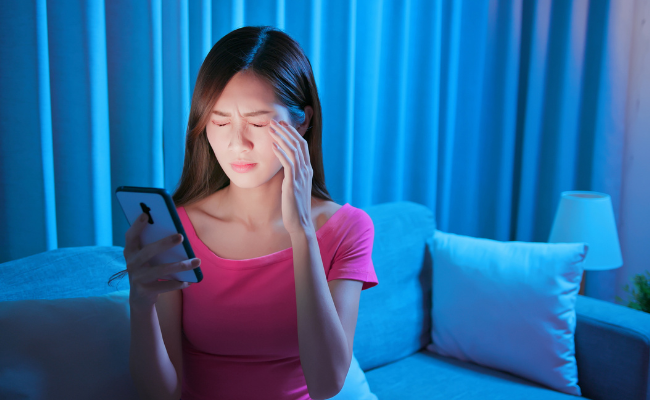How to Treat Eye Strain?
- November 08, 2023
- No Comments

What is Eye Strain?
Asthenopia, commonly known as eye strain, is a widespread condition marked by discomfort, fatigue, or pain in the eyes. It frequently manifests after prolonged engagement in activities demanding intense visual focus, such as extended periods of staring at a computer screen, reading, or driving. This condition arises from the extended and intense use of the eyes, encompassing tasks like reading, using digital devices, or prolonged periods of driving, and is interchangeably termed eye fatigue or asthenopia.
Why Does Eye Strain Occur?
Several factors contribute to the development of eye strain. One primary reason is prolonged exposure to digital screens, which emit blue light that can cause visual discomfort. Poor lighting conditions, uncorrected vision problems, and improper ergonomics while working on a computer are also significant culprits. Additionally, factors like dry eyes, allergies, or underlying eye conditions can exacerbate eye strain symptoms.
How to Identify Eye Strain Symptoms?
Recognizing the signs of eye strain is crucial for early intervention. Common symptoms include:
- Eye Discomfort: Aching or sore eyes are often the first signs of eye strain.
- Headaches: Persistent headaches, especially around the forehead and temples, can be linked to eye strain.
- Blurred Vision: Vision may become blurry or unfocused during or after prolonged visual tasks.
- Dry Eyes: Insufficient blinking while focusing can lead to dry, irritated eyes.
- Difficulty Concentrating: Struggling to maintain focus or experiencing a decrease in concentration may indicate eye strain.
- Increased Sensitivity to Light: A heightened sensitivity to light, known as photophobia, is another symptom.
How to Treat Eye Strain?
- Follow the 20-20-20 Rule: To alleviate eye strain during prolonged screen time, adopt the 20-20-20 rule. Every 20 minutes, take a 20-second break and look at something 20 feet away. This helps relax eye muscles and reduce strain.
- Adjust Lighting Conditions: Ensure proper lighting in your workspace. Position your computer screen to avoid glare and use ambient lighting to reduce contrast. Avoid working in overly bright or dim environments.
- Optimize Ergonomics: Maintain a proper ergonomic setup to reduce eye strain. Position your computer monitor at eye level, maintain a comfortable viewing distance, and use an ergonomic chair to support good posture.
- Blink Regularly: Staring at screens often leads to reduced blinking, contributing to dry eyes. Make a conscious effort to blink regularly to keep your eyes moist and refreshed.
- Use Artificial Tears: Lubricating eye drops or artificial tears can provide relief from dry eyes caused by prolonged screen time. Use preservative-free eye drops to prevent irritation.
- Adjust Device Settings: Modify the brightness, contrast, and font size on your digital devices to make them more comfortable for your eyes. Consider using blue light filters to reduce exposure to potentially harmful blue light.
- Get Regular Eye Exams: Ensure that your prescription glasses or contact lenses are up-to-date. Uncorrected vision problems can contribute significantly to eye strain.
Treatment Solutions for Eye Strain:
- Warm Compresses: Applying a warm compress to your closed eyes can help relax eye muscles and alleviate discomfort associated with eye strain.
- Massage and Stretching: Gently massage the area around your eyes and perform eye exercises to reduce tension and improve blood circulation. Simple exercises, such as rolling your eyes in a circular motion, can be beneficial.
- Anti-Reflective Coatings: Consider using glasses with anti-reflective coatings, especially if you spend a significant amount of time in front of screens. These coatings reduce glare and minimize eye strain.
- Blue Light Blocking Glasses: Specialized glasses designed to block blue light can be effective in reducing eye strain caused by prolonged screen exposure. They filter out a portion of the blue light emitted by digital devices.
Benefits of Treating Eye Strain:
- Improved Productivity: Reducing eye strain allows for more comfortable and efficient work, leading to increased productivity.
- Prevention of Long-Term Issues: Addressing eye strain promptly helps prevent the development of more serious eye conditions that may arise from prolonged discomfort and strain.
- Enhanced Comfort: Treating eye strain leads to increased comfort during daily activities, reducing headaches, eye discomfort, and fatigue.
- Better Eye Health: Implementing preventive measures and seeking treatment for eye strain contributes to overall eye health, reducing the risk of long-term complications.
Comments (0)